Letter From Cambodia
Storied Landscape
Through centuries—and perhaps even millennia—of cultural, political, and environmental change, Phnom Kulen has retained its central role in the spiritual life of a people
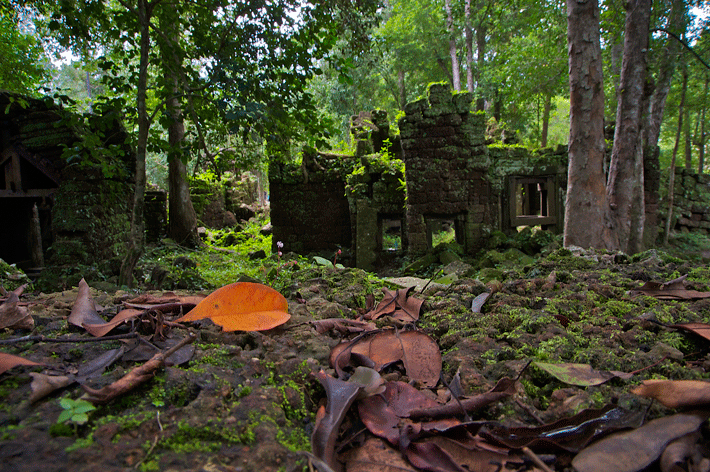 The ruins of an Angkor-era temple on Phnom Kulen remain a popular destination for both pilgrims and tourists.
The ruins of an Angkor-era temple on Phnom Kulen remain a popular destination for both pilgrims and tourists.
Northeast of the inland Cambodian city of Siem Reap, far from the crush of the morning traffic, noisy market stalls, and mobs of motorbikes stopping for noodle soup and chicken rice, an imposing plateau rises from the hot, flat land. Phnom Kulen, the “Mountain of Lychees,” reaches 1,500 feet high, stretches 15 miles long, and is nine miles wide at its broadest point. It is a rippled mountain range of thick forests and fields and streams that tumble downhill through its rocky ravines.
For millennia, Phnom Kulen has been sacred to the Khmer, the dominant ethnic group in this country both in antiquity and today. Throughout its long history, people have gone there to live and work, to worship and celebrate, and to seek solace and refuge. Kings and soldiers, Hindus and Buddhists, pilgrims and hermits, have all gone to Phnom Kulen. There, in A.D. 802, Jayavarman II declared himself devaraja, or “god king,” of a united Khmer state. And there he founded Mahendraparvata, the capital city of what would become the vast Angkor Empire that flourished between the ninth and fifteenth centuries. At its height, the empire controlled territories in what are now modern-day Cambodia, parts of Thailand and Laos, and beyond.
Phnom Kulen’s exceptional and enduring place in Cambodian life and history is, in great measure, thanks to water. It accumulates in the mountain’s porous sandstone and is released year-round into innumerable sacred pools and rivers, and into the springs and streams that once supplied the Angkor Empire, and today still feed the paddies that produce the majority of the region’s daily rice. In this way, Phnom Kulen is tied inexorably not only to the Angkor-era civilization of the past, but to modern-day Cambodia. Hundreds of generations have gone there and have left behind a record in the form of remarkable sculptures, carvings, and paintings, some of which are just now being discovered and researched. “Mountains are always closer to the gods,” says archaeologist Jean-Baptiste Chevance. “They have always been in many civilizations, many cultures, a sacred place. This is one such place.”
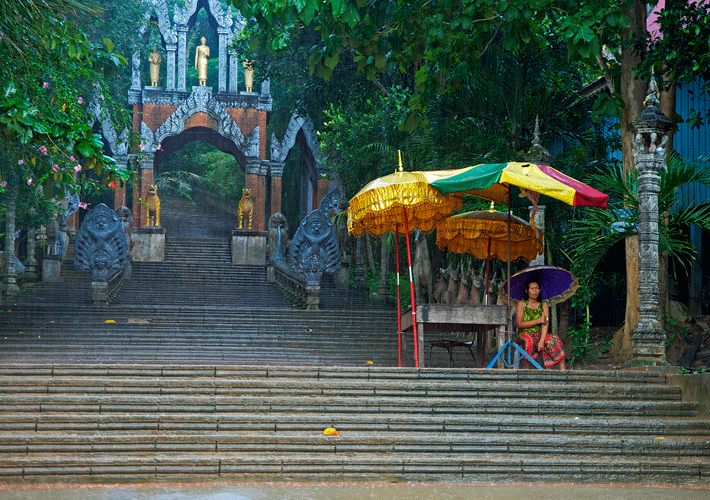
(Gunther C O Deichmann)
A woman sells Buddhist offerings on the staircase leading to the Preah Ang Thom temple atop Phnom Kulen.
Sunlight streams across the plateau as we approach the base of Phnom Kulen. It’s the week of Khmer New Year, the biggest holiday of the year, and thousands of pilgrims and partiers from across the country are convening at the mountain to celebrate. Bumper-to-bumper traffic crawls up a winding, one-lane paved road through thick forests filled with noisy cicadas that compete with the human din. Every now and then, the trees give way to expansive vistas of the plains below. I can see how this vantage point would have given Khmer sentries, or much later Khmer Rouge fighters who dug in here, clear views of approaching threats.
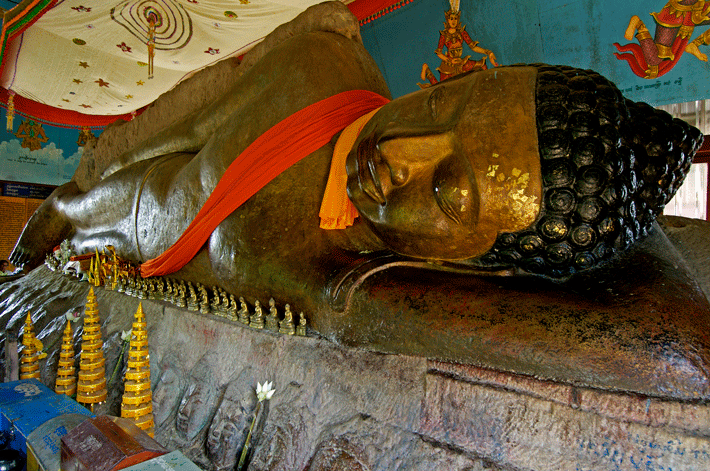
(Gunther C O Deichmann)
A golden statue of a reclining Buddha lies in the temple of Preah Ang Thom.The paved road ends in a wide, flat, rocky area near a staircase leading to Preah Ang Thom, a sixteenth-century monastery with a golden sculpture of a giant reclining Buddha. As people prepare to observe the New Year, the landscape is a hive of activity. The air is fragrant with incense and lotus, music blares from loudspeakers, and vendors sell trinkets, hats, sarongs, fried fish, cold drinks, and traditional medicine. Beggars line the stairs as pilgrims drop small amounts of money into their hats—helping the poor is a traditional part of Buddhist celebrations. The Buddha room, high in a tower accessible only by steep steps, is dense with people who come to pray—and then photograph themselves on their cell phones. This happens all week long throughout the New Year festivities.
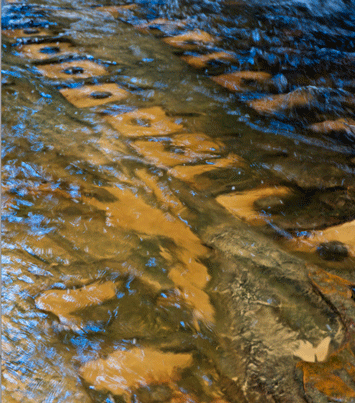
(Gunther C O Deichmann)
The sandstone bedrock of the River of a Thousand Lingas is covered in carved representations of the power of the Hindu god Shiva.Nearby, crowds gather in the waters of the River of a Thousand Lingas, where the riverbed is covered in carved symbols of the power of the Hindu god Shiva. Children slide downriver on their hands, shrieking happily. A woman holds her nose and reclines, submerging her head in the refreshing flow. Along the river’s banks, families gather on mats spread across the leafy ground, digging into soup tureens and stir-fry pans.
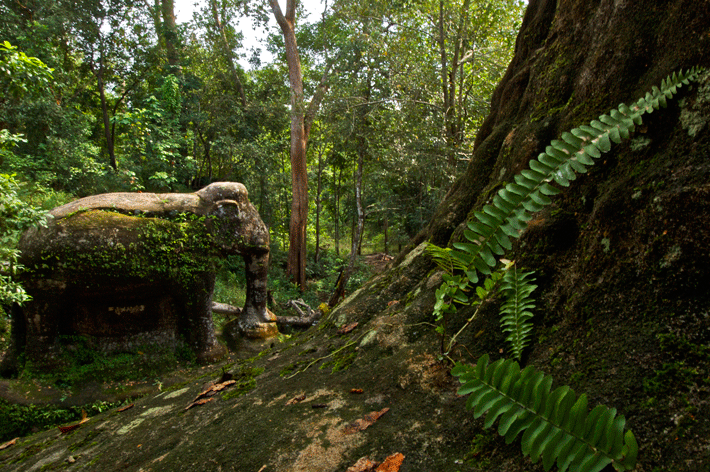
(Gunther C O Deichmann)
An Angkor-era elephant statue stands near a sacred pool at the site of Srah Damrei.
On another day during the New Year celebrations, I return to the mountain to explore sites higher up, away from all the holiday noise. Not far from the golden Buddha, we find motorcycle taxis for hire, and six of us—me; my driver, Rathana; my husband, Jerry, with his driver, Kang; and our translator, Visal, with his driver, Chieng—begin the ascent. The crowds of pilgrims and picnickers give way to quiet forest as we climb a dirt road, broken by rocky, sandy open areas, through the trees. Here, atop Phnom Kulen, a few small communities are scattered across the remote terrain and villagers live today much as their ancestors did. My right hand blisters from gripping the motorcycle seat as Rathana and I careen along the bumpy, jerky route. Following a narrow, root-strewn path, we duck to avoid branches and lean hard into the curves. Rathana is a good driver, but this isn’t a good trail.
I am more concerned, however, about land mines. Locals have told me that they are plentiful, left over from years of civil war when the Khmer Rouge controlled Phnom Kulen. The Cambodian Mine Action Centre, the country’s leading mine clearance organization, works with archaeological teams in the area and has cleared a few main paths and sites. Chevance, who founded the Archaeology and Development Fund in 2008 to foster archaeological research and conservation on Phnom Kulen, and with whom I spoke after my visit, says that villages and ancient sites, especially if they contain water, were often mined because they were likely places for soldiers to occupy. “We can’t clear the whole mountain of mines. It’s impossible,” Chevance says. “But we never go into a place local people say is mined. That would be suicide.”
After a 20-minute ride, we stop the bikes and hike to the demined site of Srah Damrei, where large Angkor-era stone elephant and lion statues guard a small pond. The drivers light cigarettes and chat, resting on nearby boulders. They know it as a sacred place where locals come to pray. I peer into a puddle filled with just a few inches of water and plenty of silt, and Chieng says, “Before, there was freshwater, so it was called srah, or ‘pool.’”
We linger a few minutes, enjoying the cool, shady forest. It’s an hour past lunch, and we’re hungry, but on the way back to Preah Ang Thom there is nothing to eat. There are no restaurants, no guesthouses, and few people with food to spare. A village we pass through has only a few scattered thatch and wood huts built on stilts. Life is difficult for Phnom Kulen’s inhabitants. Most villagers are slash-and-burn subsistence farmers, and in recent years many plots of land have been converted to cashew plantations. The jungle is disappearing at an alarming rate. “You have 4,000 people now, and most of them are struggling,” Chevance later tells me. “The roads are very bad. In the rainy season they turn into rivers. There is a lot of malnourishment. Even if it’s two hours from Siem Reap, it’s still very poor.”
At the crack of dawn, Jerry and I head by taxi to the base of a prominent escarpment that forms the southeast edge of Phnom Kulen to see yet one more aspect of it. Our guide is Heng Than, a prehistorian who works with the APSARA Authority, which manages the temples and surrounding area. The car rumbles down a flat red-dirt road amid fields just starting to turn green. Ponds glisten after an early morning rain. “Right now is the short rainy season,” Heng says. The full rainy season is still a month away. We are planning to hike to the rock shelter of Poeung Komnou, a site where a recluse named Sivasoma lived in A.D. 1074 and where, ever since, he has been worshiped as a local spirit and the guardian of the mountain. On this side of Phnom Kulen there are at least 10, and possibly more, rock art sites that researchers believe might pre-date the Angkor era by thousands of years, some just steps away from Angkor-era carvings among the same rocks. We park in a field and get under way.il

(Gunther C O Deichmann)
More than 15 Angkor-era carvings depicting Hindu deities and other figures are carved into a giant sandstone boulder at Poeung Komnou.
The ground is sandy and covered in scrub. “A few years ago there were very, very big trees,” Heng says. But, he explains, they’re gone now, a casualty of the rampant logging and agricultural expansion overtaking the mountain. Not far up the trail, we meet a banana farmer named Yao Yam. Yao, who was born on this eastern side of Phnom Kulen, tells us that when he and his neighbors need water for their rice fields, they hold a special ceremony honoring the mountain spirits. Yao knows this place has held meaning for many generations before him. “When I was young,” Yao says, “my father told me there were drawings on the rock shelter.” Yao suspects this mountain might have concealed soldiers during the Angkor Empire, just as it did during the recent civil war, and he thinks those earlier soldiers might have been the ones who painted the rocks while hiding out.
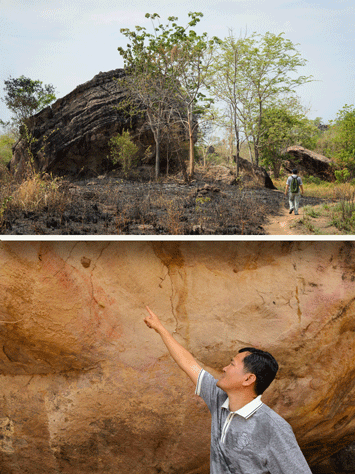
(Jerry Redfern)
Prehistorian Heng Than walks through burned fields (top) on his way to the rock art site of Poeung Komnou. Than points out (above) faint monochrome paintings of a catfish and a geometric design that pre-date the Angkor era.We continue uphill, with Heng guiding at a fast clip, through an area recently cleared of trees and burned for agriculture. It’s a hot, dry walk along a gently sloping path, scented with flowers and speckled with butterflies. We hear a chainsaw up the mountain, and Heng cringes. Next we walk through a blackened field and past a few wooden dwellings. A little farther on, suddenly, there is a giant boulder with one side forming an overhang protecting a rock face. On it I can make out a few faint red zigzag lines and a large depiction of a catfish. According to Noel Hidalgo Tan, a specialist in archaeology at the Southeast Asian Ministers of Education Organization’s Regional Centre for Archaeology and Fine Arts in Bangkok, there’s a good chance that these paintings are prehistoric, or at least pre-Angkor, with some possibly being as much as 3,000 years old, or even older. This would push the mountain’s record of human occupation much deeper into history.
Heng first visited Poeung Komnou and saw the Angkor carvings more than a dozen years ago, but tells me that initially he hadn’t noticed the paintings just around the other side of the boulder. “I had no idea about the rock art,” he says. Although locals such as Yao have long known about the images, researchers weren’t aware of them until just a few years ago, when villagers pointed them out. The Living Angkor Road Project, a joint Thai-Khmer research effort aimed at identifying Angkor Empire roads, has now begun to investigate the paintings here. The study of rock art is a relatively new field of research in Cambodia. “It’s still just the beginning,” Heng says. Although right now the archaeology is still unclear, according to Tan, these sandstone boulders might yet say a great deal about the people who pre-date the Angkor Empire. Researchers think the early painters lived in many of the rock shelters they decorated, but aren’t sure yet whether these were permanent or seasonal habitation sites.
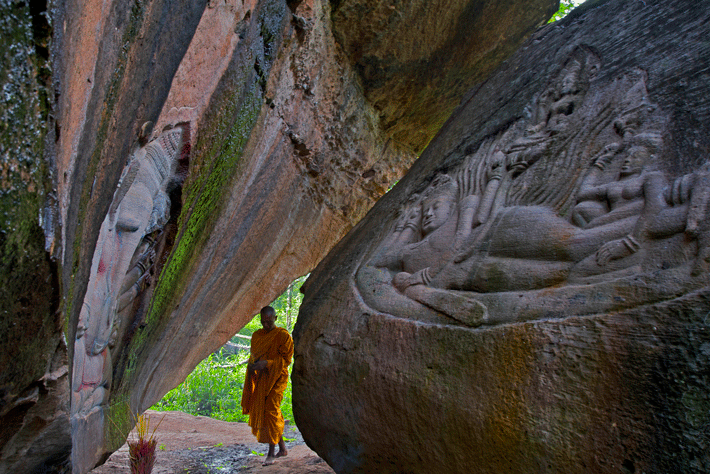
(Gunther C O Deichmann)
At Poeung Komnou, a Buddhist monk walks between carvings of the gods Ganesha and Vishnu.
The boulder, situated as it is, has one of its surfaces quite close to another massive rock. On that face, a striking Angkor-era carving of the Hindu god Vishnu reclining on his side appears to look at an equally remarkable carving of the elephant-god, Ganesha, across the gap. I tiptoe through the passage to the other side of the boulder. Taking a few steps more and rounding the corner, I am amazed at the sight on the other side—more startling Angkor carvings of Hindu deities with meditating ascetics at their feet.
As Heng, Jerry, and I make our way back to Siem Reap, we pass a couple on the roadside carving wooden logs a foot in diameter and 20 feet long, to be used as house pillars. Heng explains that the tools the couple are using are modeled on Stone Age and Iron Age designs. One is an ax called a pu tau, and the other is a dung, a metal wedge blade on a crescent-shaped wooden head attached to a wooden handle. For more than a thousand years, inhabitants of Phnom Kulen have been using implements like these to cut down trees and, when turned another way, to smooth the wood.
An old quarry in a shallow stream just down the road tells a similar story. Looking closely, I can see grooves, likely Angkor-era, cut two inches into stone amid scratches made by modern villagers’ knives. Locals still sharpen their tools on the rock’s surface here. Their tools, like Phnom Kulen itself, are a living link to the past.
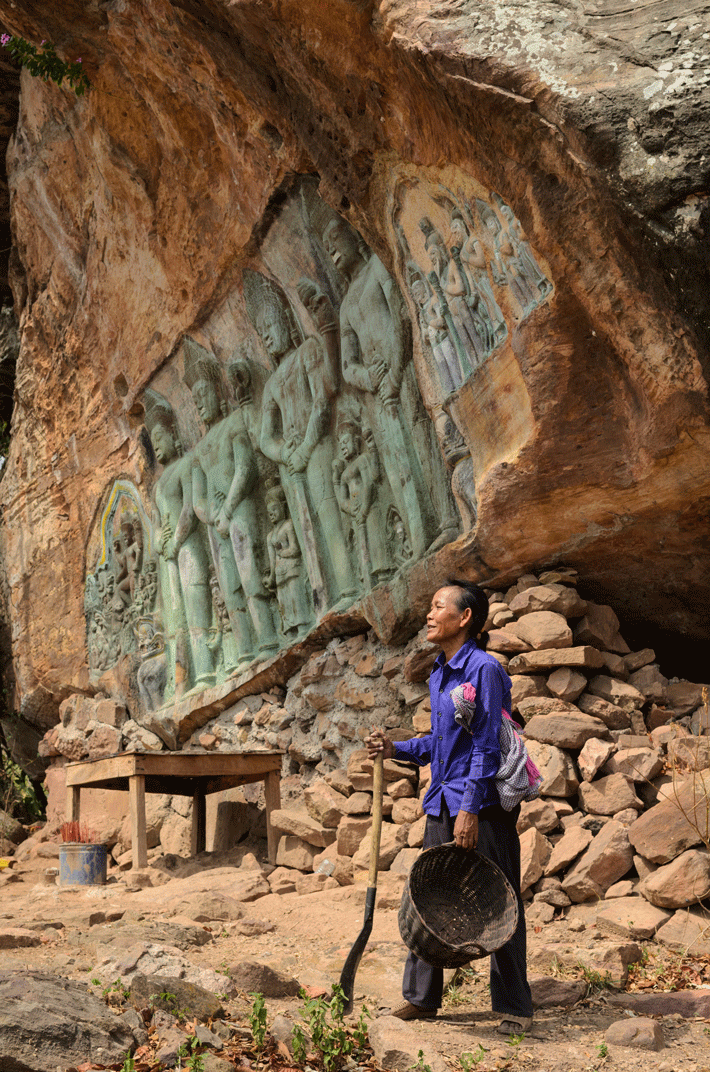
(Jerry Redfern)
A local woman named Nyap stands beneath Angkor-era carvings of Hindu gods at Poeung Komnou. She lives in a hut a few hundred yards away.Once back in town, I recall a woman I met at Poeung Komnou, something of a recluse like Sivasoma centuries before her. Her name is Nyap, and as she stood beside the Angkor-era carvings, examining and pointing to the intricate details in the images of deities, she began to recount her long journey to Phnom Kulen. Just back from the forest, Nyap held a blade in one hand, a basket in the other, a checkered krama scarf tucked under her arm. She led me to her outdoor cooking area, just a short walk from the carvings. As she squatted to the ground and lit a wood cooking fire beneath her pot of rice, she told me she rarely has enough to eat, but that she is at peace now. She had been sick and alone at home in a distant province when she awoke from a dream, knowing this mountain would heal her. “God pushed me to come to this place,” Nyap said. “When I came here everything inside my body was changed.”
Karen Coates is a senior fellow at the Schuster Institute for Investigative Journalism and the author of Eternal Harvest: The Legacy of American Bombs in Laos.


No comments:
Post a Comment